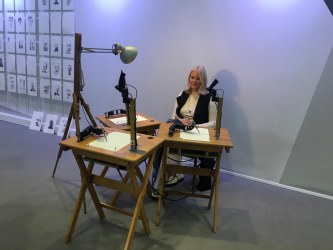In January our friends at Science Gallery International had an exciting, meaningful and worthwhile week in Davos, Switzerland at the World Economic Forum 2017. With the support of the Wellcome Trust, Science Gallery International partnered with the World Economic Forum to engage world leaders on how to enable young people’s creativity to meet the challenges of the Fourth Industrial Revolution. And it seems there’s no better way of doing that than with a Science Gallery exhibition!
Two exhibition pieces from SEEING took pride of place in Davos: 3RNP (or, 3 Robots Named Paul) by Patrick Tresset and Peeping Hole by Kenichi Okada and Naoaki Fujimoto. Both proved to be a big hit with attendees, with some really interesting and inspiring people like the Crown Princess Mette-Marit of Norway, musician and maker Imogen Heap, senior Wellcome Trust advisor Clare Matterson, NSF director France Córdova, artist and Humanae creator Angélica Dass, and hundreds more stopping by to peep through the mysterious hole and be drawn by Paul, Paul and Paul (who are now crossing the Atlantic Ocean en route to Miami, where SEEING will be at the Patricia and Phillip Frost Museum of Science from early March.)
Science Gallery International’s executive director Andrea Bandelli was one of the Cultural Leaders invited to Davos, and Sarah Durcan, Noeleen Hartigan and Danny Browne were part of the Science Gallery contingent who engaged with the World Economic Forum’s participants from all over the world.
What was immediately obvious in the conversations at the Forum was that creativity is a really serious and vital issue today – and was recently named in the top three most important skills to have in the future in this report. The best example to understand why creativity is fundamental today is AI – Artificial Intelligence. In Davos the ceo of Accenture told that last year they have made 70.000 positions redundant, substituted by AI. In many other conversations, on and off the record, it was clear that the global companies that attend the Forum are seriously preparing for a complete revolution of their workforce requirements. At the same time, the changes that begin now to be dramatically under our eyes were unthinkable only a few years ago, even by those who were actually working on AI. Sergey Brin, the co-founder of Google, admitted he didn’t see it coming at all – his interview at the Forum can be watched online here.
But the mood of the Forum’s participants was not at all gloomy and worried; on the contrary, AI offers the opportunity to invent completely new jobs and ways to contribute to society in formats that are unthinkable today. And that’s where mastering creativity – seriously – becomes essential. The problem, however, is the formal education system is not up to the task. Schools today are delivering masses of job seekers, when what we need instead is job creators. The importance of the entrepreneurial spirit in creating new activities and new jobs was stressed multiple times during the whole conference. The need to seriously address the inadequacy of the formal education system was echoed in several sessions and private conversations, with a loud and clear point that teaching STEM is not enough: creativity and critical thinking won’t be enabled by STEM alone. The arts and humanities are fundamental to enable and strengthen critical thinking, alongside more ‘liquid’ skills of social interaction, self confidence, humbleness and awareness. If there is one take from the Forum, is that we’re going to see a radical change of the role that formal education plays in society. How we are going to harness that change will define the society we will live in.
Public engagement in science was also discussed at the Forum. Fabiola Giannotti, director of CERN, stated that public engagement activities become more and more important in the cv of researchers. Their career is still determined by publications and impact factor, but it seems there is a general willingness by the heads of organizations such as CERN, NSF and the European DG Research to recognize that public engagement can have a formal role. Embedding public engagement in the practice of doing research is of course central to the work that Science Gallery and other hundreds science centres do, and we were very happy to be able to talk about this with the “big bosses” at the Forum. (if you want to hear more about this you can watch the “Global Science Outlook” session here (and keep an eye out for Andrea raising the point of public engagement at 42:30!)
A lot is written about Davos and its peculiar setup; but it’s not all only about elites rubbing shoulders with each other. Of the most emotionally touching initiatives was A Day in the Life of a Refugee. It is a simulation, for one hour, of what it means to live in a refugee camp. With all the limitations of a simulation, it gives a powerful first hand experience of what it means to be stripped of your dignity, values and hope. And yet, in the conversations Andrea had afterwards with some of the women and men who spent several years of their lives in refugee camps, the one thing they mention that was key for them to survive was education. What kept them going was the knowledge that no matter what, there is always a way to improve the human condition, even when you think you can’t take it any longer.
If you are still worried about how many jobs we’ll lose because of AI, however, no need to worry: come and check out what the future looks like at HUMANS NEED NOT APPLY, the new exhibition at Science Gallery Dublin!





